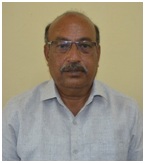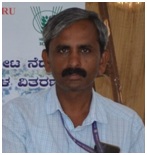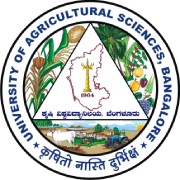
| AICRP Scheme : Agroforestry | ||||||||||||||||||||||||||||||
| Location : UAS, GKVK, Bangalore | ||||||||||||||||||||||||||||||
| Year of Start : 2004 | ||||||||||||||||||||||||||||||
| Mandate :
Ø District tree survey Ø Collection and selection of elite trees of Simarouba glauca, Tamarindus indica andMelia dubia Ø Establishing clonal seed orchard of Tamarindus indica and Melia dubia Ø Development of different Agroforestry systems Ø Participatory research and demonstration of Agroforestry based Integrated Farming Systems Ø Implementation of Schedule caste sub plan/ Tribal Sub Plan |
||||||||||||||||||||||||||||||
| Research Programmes :
v Evaluation, Selection and establishment of clonal seed orchard of Tamarind: Twenty-seven tamarind germplasms were collected from different sources and planted in Clonal seed orchard at GKVK during 2010, 2011 and 2012. v Dryland orchard-based agroforestry system: Fruit crop viz., Anacardium occidentale, Syzygium cumuni and Mangifera indica based agroforestry system was established during 2010 with inter & intra row spacing of 10 m. v Multi location trial on Pongamia pinnata: Eight selections of Pongamia pinnata viz., RAK-2015-01, RAK-2015-02, RAK-2015-03, RAK-2015- 04, RAK-2015-07, RAK-2015-08, RAK-2015-09 & RAK-2015- 10 were planted during 2017. v Development of silvi-pasture system under Melia based Agroforestry system v Development of silvi-pasture system under Melia based Agroforestry system: 198 trees were grown with three different spacing S1-12 m x 3 m, S2-10 m x 3 m and S3- 8 m x 3 m planted during 2010 v Development of medicinal + Melia dubia Agroforestry system: Evaluation of aromatic crops under Meliadubia based Agroforestry system v Sandal based agroforestry system: Trees were grown with three different spacing 5 m x 5 m, 5 m x 4 m and 5 m x 3 m planted during 2020. v Spacing trial on Mahogany based agroforestry system: Trees were grown with three different spacing 5 m x 5 m, 5 m x 4 m and 5 m x 3 m planted during 2020. v Spacing trail on Casuarina: Two germplasms (MTP-1 and MTP-2)planted during 2022 were grown with three different spacing 1.0 m x 1.5 m, 1.5 m x 1.5 m and 2.0 m x 1.5 m under two different conditions (rainfed and irrigation) v Agroforestry based IFS demonstrated: Boundary and Bund planting – Melia, Sesbania, Silver oak, Glyricedia, Neem, Casuarina etc. v Establishment of Arboretum |
||||||||||||||||||||||||||||||
| Research Accomplishments:
Ø Tamarind germplasm GKVK-17 was released for commercial cultivation: The proposed variety is high yielding and superior to local variety and well suited for maidan parts of Karnataka. Characterized with high pod weight, pulp to seed ratio and dark brown pulp colour. Hence, it was released for Eastern dry zone of Karnataka during 2014-15. Ø Drip irrigation based aerobic rice ü Drip irrigation in direct seeded aerobic rice recorded 15-17 per cent higher grain yield besides savings 49-57 per cent irrigation water as compared to transplanted rice. ü Irrigation scheduling 125 per cent E pan during early stages +150 percent from tillering to panicle emergence and 200 percent during grain filling recorded higher yield ü Drip fertigation scheduling at 2-4 days interval recorded higher grain yield Ø Drip irrigation in sugarcane ü Subsurface drip irrigation recorded higher can yield by 50-60 per cent and recorded 45-61 per cent water saving ü Drip irrigation scheduling @ 100 per cent E pan recorded higher cane yield ü Drip fertigation up to 8-9.5 months of planting recorded higher cane yield Ø Melia dubia based agroforestry systems recommended for block, boundary and bund planting ü Melia recommended for bund planting, boundary plantations and block plantations ü Recommended spacing for block plantation is 5 m x 5 m and 2-3 meters for bund and boundary plantations. ü Intercrops are recommended up to 4 years under block plantation ü The intercrops viz., Cowpea, Finger millet, Pigeon pea, Soybean can be grown economically without yield reduction up to 4 years. ü After four years shade loving grasses can be grown profitably Perennial tree fodder-based agroforestry system ü Tree based agroforestry system is the ideal for fodder production during lean period. ü Agase, Moringa, Glyricidia, Calliandra, Subabul are ideal multicut tree species for fodder production. ü Alley spacing of 3 – 5 m depending on the convenience. Ø Sesbania is recommended as a fodder tree ü Sesbenia grandiflora as a tree component planted along the bunds recorded 11.09 t ha-1 which helps in providing nutrious fodder to the livestock component especially to the milching cows. ü The yield of fingermillet as an associate crop on either side of the tree rows was reduced only 8.7 per cent as compared to pure crop. Ø Perennial tree fodder species for leaf meal production ü Five species of fodder trees viz., Sesbania grandiflora, Gliricidia sepium, Leucaena leucocephala, Calliandra calathyrus and Moringa olifera. ü Among five tree species studied for leaf meal production, Sesbania grandiflora has recorded higher green biomass yield of 4.63 kg tree-1 cutting-1 followed by Leucaena leucocephala 3.38 kg tree-1 cutting-1. ü Leucaena leucocephala also recorded higher per cent of crude protein and crude fibre content. ü Ether extract, total ash and nitrogen free extracts were higher in Moringa olifera, Gliricidia sepium and Sesbania grandiflora respectively. Ø Tree survey ü The tree survey was completed in ten districts of Karnataka namely; Chamarajanagar, Mysuru, Mandya, Ramanagara, Hassan, Bangalore Rural, Tumkur, Chikkaballapura and Kolar. ü Bund planting and boundary planting is common agroforestry practices followed by the farmers in all the districts of Karnataka. ü Agroforestry practices observed are agri-horti-silvi, agri-silvi-pasture, agri-horti-pasture and silvi-pasture. ü Major consideration for adopting agroforestry practices among the farmers was to obtain monitory benefit, to meet household requirements and for green manuring. ü The common tree species in the agroforestry system noticed are: Tamarind, Neem, Pongamia, Jack, Coconut, Mango, Acacia, Ficus, Teak, Casuarina, Sesbania, Silver oak, Syzygium, and Melia dubia. Ø 1 ha Agroforestry based Integrated Farming System module for zone 4 and 5 Ø Carbon sequestration potential of tree borne oilseeds ü At 10 years, the above ground carbon stock was significantly higher in Melia dubia (42.73 t ha-1) followed by Azadirachta indica (16.40 t ha-1) and Simarouba glauca (15.61 t ha-1) ü Significantly lower tree carbon stock was witnessed in Calophyllum inophyllum (1.21 t ha-1). ü Melia dubia sequestered considerable quantity of atmospheric carbon because of more biomass accumulation and vigorous growth Ø Carbon sequestration potential of Melia dubia at different planting densities under agroforestry system ü The above ground carbon stock was significantly higher in 8 m x 5 m (87 t ha-1) followed by 10 m x 5 m (84 t ha-1) and 12 m x 5 m (75 t ha-1). ü Significantly lower tree carbon stock was recorded in the spacing 24 m x 5 m (57 t ha-1). The difference witnessed in tree carbon stock depended on land-use pattern and intercrops cultivated. Ø Carbon sequestration potential of Teak at different planting densities under agroforestry system ü Significantly higher carbon stock was recorded in 12 m x 3 m (32 t ha-1) followed by 10 m x 3 m (27 t ha-1) and 8 m x 3 m (23 t ha-1). ü The difference witnessed in tree carbon stock depended on land-use pattern, canopy spread of tree and agro-climatic conditions Ø Precision nutrient management through drip irrigation in maizeaccepted in the year 2018-19 Ø Drip fertigation in groundnutaccepted in the year 2018-19 Ø Fertigation in aerobic rice.accepted in the year 2018-19 Ø Sensor based irrigation management in maize. accepted in the year 2023 Ø Sensor based irrigation management in baby corn. accepted in the year 2023 |
||||||||||||||||||||||||||||||
| Awards / Recognitions:
v Received Ambedkar’s Gold medal award for my Ph.D, awarded on 24th April, 2017 during 51st Convocation held at UAS, GKVK .Dr. D. C. Hanumanthappa. v Received best IFS model field demonstration award during Krishimela 2017 held at GKVK, Bangalore. v Best Integrated Farming systems Demonstration Plot award during Krishimela 2019 held at GKVK, Bangalore on 27th October 2019. v Best poster presentation Award at National Conference on Arid Fruits held at University of Agricultural Sciences, Raichur on 30th November, 2019, UAS, Raichur. Dr. D. C. Hanumanthappa v Best Agroforestry based Integrated Farming System Demonstration awarded by University of Agricultural Sciences, GKVK, Bangalore in krishimela-2022 v Best Service Employee Award in Technical Series to Mr.Ranganatha, S.C. awarded by University of Agricultural Sciences, GKVK, Bangalore |
||||||||||||||||||||||||||||||
| Facilities Available:
Laboratory is well equipped with instruments likepH meter, EC bridge, Distillation unit, Nitrogen analyser, Flame photometer, Shaker, Humehood chamber, atomic absorption spectrometer, Gas chromatography, Leaf area meter, Spectrophotometer, Hotplate, Gas collection chambers, Leachate tubes, Altimeter, Lux meter, Capony analyser, SPAD Meter, TDR, Moisture meters, Tree cutter, Tree pruner, GRS densitometer, Sensor based irrigation automation unit water source: Bore well, Data center, Shade house, Solar based pump for water lifting, Mini power tiller |
||||||||||||||||||||||||||||||
| Other Activities : Implementation of SCSP and STSP
Ø Schedule Caste Sub Plan (SCSP): Conducting on farm field demonstrations and training programmes on bund and boundary plantations and distribution of forestry seedlings (Silver oak, Mahagony and Melia dubia), horticultural seedlings (Cashew, Coconut, Lemon and Mango) and agricultural implements (Spade, sickle, varvari and basket) to identified schedule caste beneficiaries. Ø Schedule Tribe Sub Plan (STSP): Conducting on farm field demonstrations and training programmes on bund and boundary plantations and distribution of forestry seedlings viz., Silver oak, Mahagony and Melia dubia, horticultural seedlings viz., Cashew, Coconut, Mango and Lemon and agricultural implements viz., spade, sickle, varvari and basket to identified schedule tribe beneficiaries. Ø Served as member in organic farming village evaluation team constituted by Director of Research, UAS, GKVK, Bangalore – 560 065 and evaluated Chikkavittenahalli, Channapatna Taluk, Tenginakallu, Ramangar, Veerasagar, Magadi, Kolalagundi, Kanakapura Taluk, Ramanagar District. – Dr. D. C. Hanumanthappa. International Exposure – Dr. D. C. Hanumanthappa. Ø Visited Germany from 7th to 14th November, 2019 under the project The rural –urban interface of Bangalore: A Space transitions in Agriculture economics and society and sub project – Effects of Agriculture water and nutrient management on farmers livelihood (GOI-DBT, A01) Participation as Lead speaker/ Chairman/ Co-Chairman/ Rapporteur/ others in conferences/ seminars/ symposia/ workshops/ training programmes/ winter school/ summer school/ other eventsDr. D. C. Hanumanthappa.
|
||||||||||||||||||||||||||||||
|
Externally Funded Projects in Operation:Dr. D. C. Hanumanthappa |
||||||||||||||||||||||||||||||
| Sl.
No. |
Project Title | Funding agency
|
Year of
Completion |
|||||||||||||||||||||||||||
| 1 | Sensor based automated irrigation techniques in important agricultural crops. | RKVY | 2023 | |||||||||||||||||||||||||||
| 2 | Revolving fund project on maintenance of animals, vermicompost and nursery activities in Model IFS demonstration | DR grants, UASB | Long term | |||||||||||||||||||||||||||
| 3 | Demonstration of agroforestry-based IFS and Sensor based automated irrigation techniques in important agricultural crops at ZARS, GKVK | UASB grants | Long term | |||||||||||||||||||||||||||
| 4 | Agronomic evaluation of Kadiri, Lepakshi groundnut and other varieties for enhanced productivity and efficiency | DR grants | 2024 | |||||||||||||||||||||||||||
| 5 | The Rural-Urban Interface of Bangalore: “Soil & water quality in Agricultural systems along the urban interface” | GOI-381 / DBT Indo-German Project – II Phase | 2024 | |||||||||||||||||||||||||||
| Testing trials | ||||||||||||||||||||||||||||||
| Sl. No. | Name of the Project | Funding
agency |
Budget
(Rs. In lakhs) |
Year of completion | Scientist | |||||||||||||||||||||||||
| 1. | Testing Trial on LCO fortified WSF and bio-fertilizers in Paddy and Tomato | Novozyme South Asia Pvt. Ltd. | 5.15 | 2023 | Dr. Hanumanthappa, D.C | |||||||||||||||||||||||||
| 2. | Evaluation of yaravita optimaris for growth and yield parameters of tomato | Yara fertilizers India pvt. ltd. | 3.24 | 2023 | Mr. V. Bhaskar | |||||||||||||||||||||||||
Staff Profile:
Scientific staff:

Academic Qualification : M.Sc. (Horticulture)
Area of Specialization : Horticulture
Date of joining duty at UAS, Bangalore :18-02-1991
Date of Joining Scheme /Unit : 30-11-2012
uasb.agroforestry@gmail.com
bhaskaragroforestry@gmail.com

Academic Qualification : Ph.D
Area of Specialization : Agronomy
Date of joining duty at UAS, Bangalore : 14-03-2007
Date of Joining Scheme /Unit : 16-06-2017
dhdeeta@gmail.com
-
- Page Visitors Count:
- Last Updated: March 19, 2025
- Site Statistics




